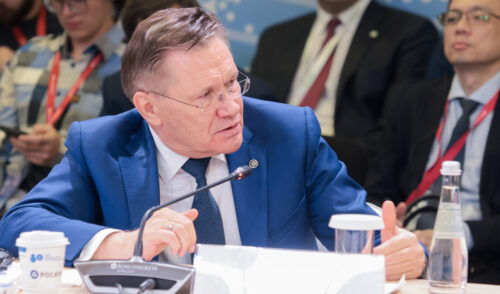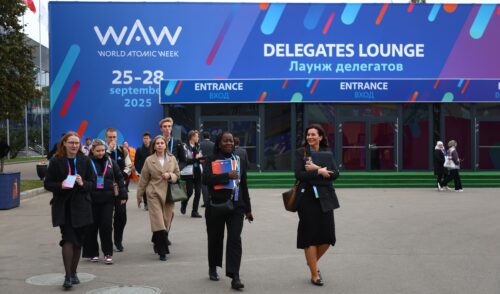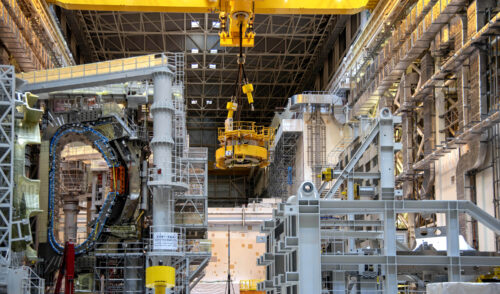
News of construction sites
back to contents“Transition will be performed after successful completion of all commissioning operations and corresponding permission of Rostekhnadzor”, – said Alexander Vologdin, the assistant to the general director of “Atomtechenergo” (specialized enterprise, which primary goal is to perform commissioning operations and tests during commissioning of new power units of the NPP, as well as to assist operation of nuclear power plants) at the meeting of new power units construction office.
Power of reactor facilities will be gradually increased from 50% to 100% at the stage of trial operation. After that the power unit will be accepted for commercial operation. Power unit 3 operates at 30% power at the stage of power start-up.
Rostov NPP power unit 4 construction deadlines were also considered in the office meeting. As of now, construction operations gradually proceed there to heat and electric installation works. After recent installation of the containment dome portion the erection gang started final assembling of the polar crane and will further start its adjustment. This crane will be used to install all heavy equipment of the reactor department, including the reactor vessel, which is expected to arrive to the construction site this summer.
The builders will be entrusted with a task to complete the basic part of heat equipment installation works in the main building in 2015. Works on the evaporative cooling tower shall be also completed by the end of the year.
Ahead of schedule
Welding of the main circulation line of Leningrad NPP-2 power unit 1 was completed ahead of schedule; this unit shall progress to the physical start-up stage by the end of this year. This made Leningrad NPP-2 commissioning a step closer. Main circulation line connects the basic equipment of the primary circuit: reactor, steam and gas generators and reactor recirculation pumps. It provides coolant circulation, which cools the core, and transfers heat to generators. 140 days were allocated to weld the circulation line 160 m long. But specialists managed to complete this work ahead of schedule — in just 109 days. They worked stage by stage: assembly, perlitic part welding, high-temperature treatment, application of protective building-up welding and step-by-step control of all operations. Denis Shnel, the head of non-destructive metal testing and technical control department of Leningrad NPP-2, told that all kinds of non-destructive control (visual, control by measurement, X-ray inspection, penetrant test and ultrasonic examination) were performed for each welded connection, confirming their high quality.
Yury Galanchuk, Leningrad NPP-2 director, pointed out that absence of welding defects is reasoned by many factors: organization of the technological process, high qualification of welders, correctly selected welding materials of high quality. Besides, high speed and quality are the result of the advanced technology applied: welding was performed simultaneously for four joints. “Completion of MCL welding will commence works on installation of pumping systems on the decompressed reactor,” summed up the director of the plant under construction.
Another unit planned to start up this year is Novovoronezh NPP-6. Pumping of safety systems on the open reactor of the power unit is planned on March 2, 2015. Currently there are the following systems in high readiness: main circulation lines, cooling pond water supply for cleanup, active drains of the reactor building (free-flow part), distillate system. Electric motors of four pumps of another safety system — emergency borating system — were successfully tested at no load within works related to post-installation equipment cleanout, one day ahead of schedule.
NPP receives the equipment
Five diesel power plants arrived to the site of Baltic NPP under construction; each plant is of 89 tons mass. Capacity of one plant makes 6300 kW. This equipment ensures functioning of the power unit safety systems in case of complete power failure and switches the power unit to safety condition in case of any external effects. Now the received equipment is stored in industrial warehouses.
Works on erection of temporary establishments, storage facilities for equipment acceptance and storage, as well as works on equipment manufacturing for the plant according to contracts already concluded, are currently ongoing at the construction site of Baltic NPP.
“At the fabrication stage within contracts concluded earlier there is variety of equipment units and important components from other large European companies, including companies from France. As of today the first batch of equipment for the first power unit of Baltic NPP has already arrived from Saint-Nazaire, France, to Baltiysk port. Deliveries of the second batch for the second plant unit have also started,” said Vitaly Trutnev, Baltic NPP director.




